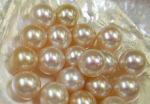Southsea Pearl
Silver/Yellow lipped pearl oyster
Pearl producing techniques were brought to the Philippines, Australia, Myanmar (called Burma at that time) and Indonesia in the first half of the 20th century by a few pioneers. Over the last 60 years a significant growth of the South Sea pearl industry could be observed, and the business is still growing.
The pearl oysters which produce South sea pearls are bigger than those producing Akoya pearls. Normally they reach hand size and some even the size of a dinner plate. These oysters usually produce pearls sized 9 to 15 mm and some pearls can even reach diameters of over 20 mm.
The colour of the pearls varies due to the oyster species used and the environment in which they are growing. For example the white-lipped South Sea pearl oyster creates green, blue, silver, grey or pink tinted pearls, whereas the yellow-lipped species produces cream, yellow or golden coloured pearls.
Black lipped pearl oyster(Tahitian)
The discovery of the Pinctada Margaritifera oyster, an oyster species with dark shells, by pearl scientists encouraged pearl production to spread to Tahiti and French Polynesia in the 1960s.
The colours of Tahiti Pearls range from dark shades like black, grey and brown to silver blue. Some even have an overtone in red, green or blue.



